You'll find voile to be one of the most versatile sheer fabrics in textile manufacturing, distinguished by its plain weave construction and high-twist yarns. This lightweight material, typically made from silk, synthetic or cotton fibers, offers remarkable breathability and an ethereal drape that sets it apart from other transparent textiles. Whether you're considering it for fashion or home décor, understanding voile's key characteristics and applications will prove essential for maximizing its potential in your projects.
Key Takeaways
- Voile is a lightweight, sheer fabric made from cotton or silk with a slightly crisp finish and semi-transparent appearance.
- The woven fabric features high-twist yarn construction, creating excellent draping qualities while maintaining structural integrity.
- Common uses include summer dresses, curtains, scarves, and bridal wear due to its flowing and ethereal qualities.
- Available in cotton, silk, polyester, and stretch varieties, each offering different levels of transparency and performance characteristics.
- Best maintained through gentle washing, air drying, and low-heat ironing, while styling works well with layering techniques.
What is Voile Fabric?
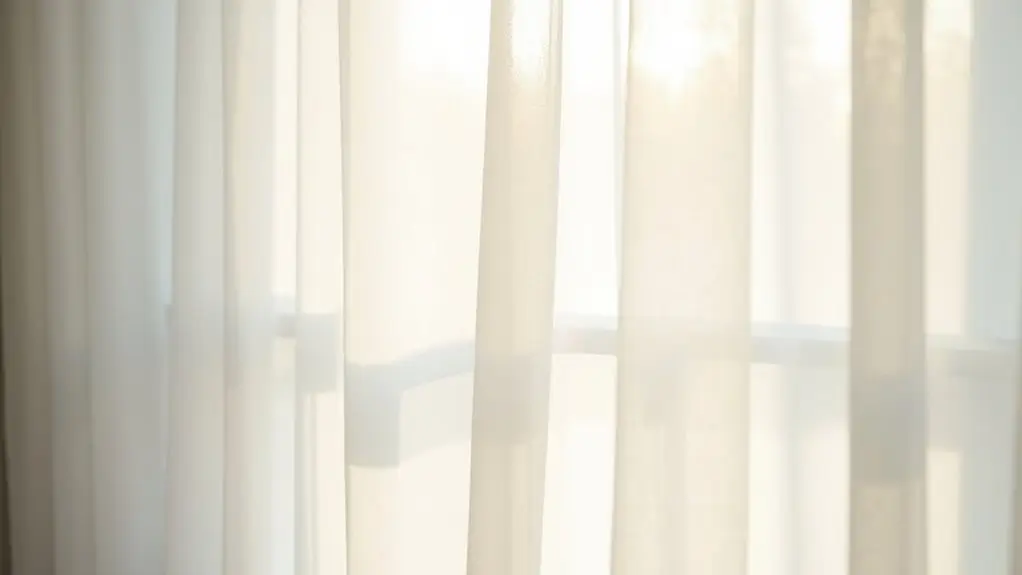
Voile stands as a soft and delicate textile characterized by its distinctive high-twist yarn construction and plain weave pattern. You'll find that voile is a lightweight fabric, typically made from natural fibers like cotton or silk, though synthetic blends are also common. The fabric's French-derived name, meaning "veil," perfectly describes its sheer quality and delicate drape. Despite its airy appearance, voile's higher thread count ensures durability and shape retention.
Characteristics of Voile
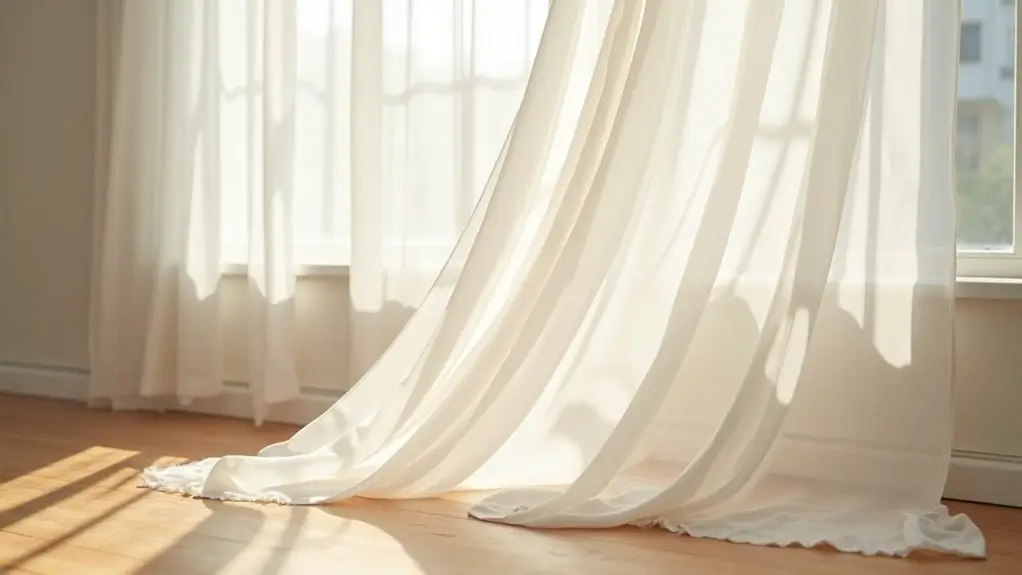
Voile fabric exhibits distinct tactile and structural properties through its high-thread-count weave, resulting in a smooth hand-feel and semi-transparent appearance that's characteristic of this textile. You'll notice the fabric's exceptional drape flows gracefully due to its lightweight construction, while maintaining structural integrity through its tight weave pattern. The open weave structure creates natural ventilation channels between fibers, making voile remarkably breathable while remaining durable enough for regular wear.
Texture and Feel
The signature texture of voile fabric emerges from its distinctive twisted yarn construction and open weave pattern.
You'll notice its exceptionally soft and breezy feel against your skin, characterized by a lightweight drape that's both fluid and graceful. The fabric's intricate yarn twisting technique creates a smooth surface texture that's unmistakably refined, setting it apart from standard cotton weaves.
When you handle voile, you'll experience its delicate semi-transparency and remarkable breathability.
The fabric's unique construction allows it to maintain its airy quality while providing enough structure to create elegant silhouettes in garments and home textiles.
Transparency
Building upon its distinctive weave structure, transparency emerges as a defining attribute of this classic textile.
You'll notice voile's semi-sheer quality varies significantly across its color spectrum, with lighter shades offering greater translucency than darker ones. This calculated transparency allows you to achieve different levels of coverage in your garments and décor applications.
When working with voile, you'll find its see-through nature requires strategic implementation.
While this characteristic makes it perfect for layered fashion pieces and breezy window treatments, you might need to incorporate lining for certain garments where additional opacity is desired.
Drape and Flow
Among fabric characteristics, voile's exceptional draping ability stands as a hallmark of its construction, stemming from its high-twist yarn structure and balanced plain weave.
You'll notice how voile's tightly woven yarns create a fluid drape that flows gracefully over contours. The fabric's lightweight composition ensures unrestricted movement, while its soft hand contributes to a natural fall that's essential for creating elegant silhouettes.
When you're working with voile, its breathable structure prevents stiffness, allowing the fabric to maintain consistent flow throughout wear. The material's semi-sheer quality enhances its draping potential, making it perfect for layered designs that require graceful movement.
Breathability
Air flows effortlessly through voile's distinctive plain weave construction, establishing it as one of the most breathable textile options available.
Cotton voile's exceptional moisture-wicking capabilities complement its lightweight breathability, making it an optimal choice for summer garments.
The fabric's semi-transparent nature isn't just aesthetic—it directly results from the specialized weaving technique that creates spaces between yarns. This intentional construction allows you to stay cool and comfortable, particularly in humid or warm environments.
Durability
Despite its airy construction, voile fabric shows remarkable structural integrity through its distinctive tight weave pattern.
You'll find that cotton voile fabric's durability stems from its precisely engineered fiber arrangement, which resists fraying even with regular use. The fabric maintains dimensional stability with minimal shrinkage of about 3% when properly cared for.
What's particularly impressive is voile's resistance to wrinkling while retaining its delicate appearance. The natural fibers, especially in cotton variants, create a strong yet breathable structure that withstands daily wear. This balanced combination of strength and lightness makes voile a reliable choice for both garments and home furnishings.
Common Uses of Voile Fabric
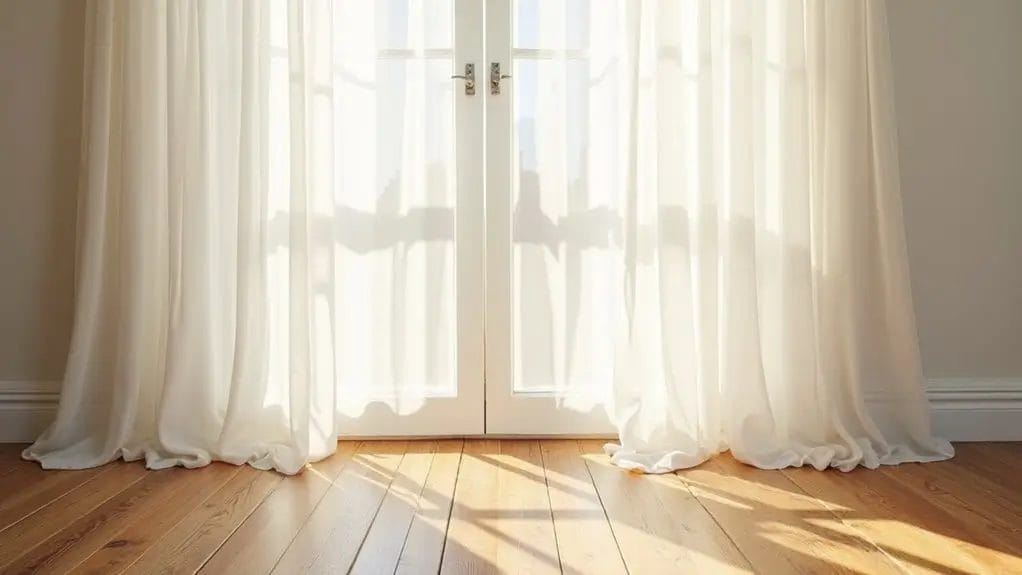
Voile's versatile weave structure allows you to transform this semi-sheer fabric into flowing garments like dresses, blouses, and layered skirts that adapt seamlessly from day to evening wear.
You'll find voile's lightweight properties particularly effective in home furnishings, where its translucent quality creates filtered natural lighting through window treatments while maintaining textile integrity.
The fabric's balanced fiber composition makes it an excellent choice for intricate craft projects, including decorative overlays, delicate accessories, and textile art pieces that require precise draping characteristics.
Fashion
While lightweight textiles dominate summer fashion, voile fabric stands out as a great choice for warm-weather garments due to its distinctive plain weave construction and gauze-like transparency.
You'll find cotton voile expertly crafted into flowing dresses, delicate blouses, and ethereal skirts that drape elegantly against the body. The fabric's semi-sheer nature creates stunning layered effects in bridal wear, where multiple tiers enhance its romantic appeal.
When selecting voile apparel, you'll notice its superior breathability and moisture-wicking properties, making it ideal for both casual and formal summer attire. The fabric's versatility extends beyond clothing, transitioning seamlessly into home accessories like scarves and shawls.
Home Decor
Three primary home decor applications showcase voile fabric's signature attributes in interior design.
- First, the semi-sheer nature of voile creates ethereal window treatments that filter natural light while maintaining privacy.
- Second, you'll find this versatile textile elegantly draped as table runners and decorative overlays, adding sophisticated layering to your dining and living spaces.
- Third, voile's lightweight construction makes it ideal for delicate upholstery accents, where you need visual softness without bulk.
The fabric's extensive patterns and colors options allow you to seamlessly integrate it into both modern and traditional interior schemes.
Craft Projects
Creative enthusiasts gravitate toward voile fabric for its exceptional versatility in diverse craft applications.
This semi-sheer textile works beautifully for wedding accessories, including veils and table overlays that create an ethereal ambiance.
For home décor projects, you can transform voile into elegant table runners and decorative pillow covers.
The fabric's fine weave structure allows for intricate embellishments and embroidery work. When layered, voile's transparent quality creates depth and visual interest in your crafted pieces.
Different Types of Voile Fabric
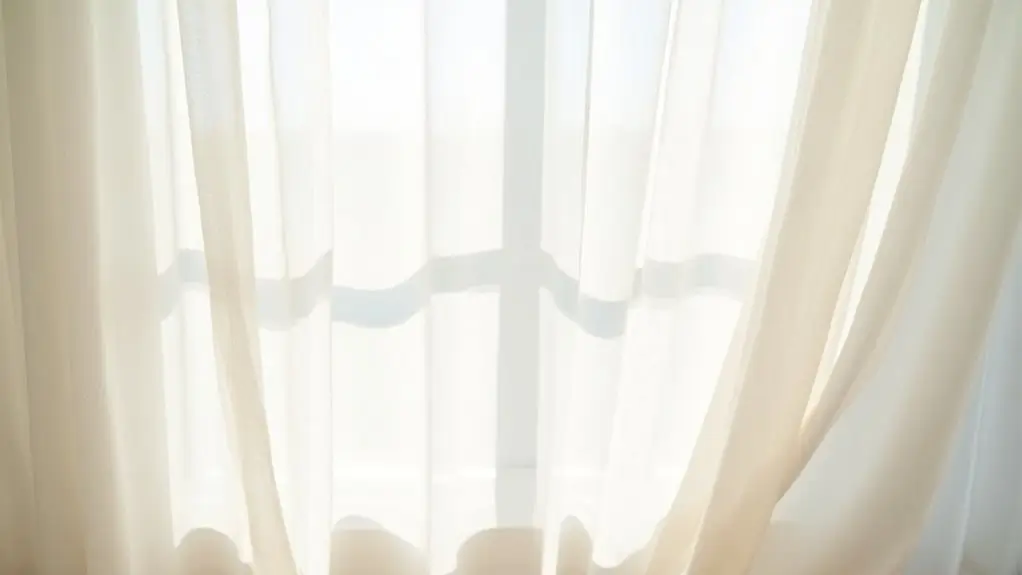
You'll find voile fabric available in several distinct compositions, with cotton voile fabric offering superior breathability through its plain weave construction and silk voile providing lustrous drape through its protein fiber structure.
Polyester voile's synthetic fibers create a crisp hand and excellent wrinkle resistance, while printed voile incorporates surface designs through direct or transfer printing methods.
Stretch voile integrates elastomeric fibers into the traditional plain weave structure, allowing for enhanced mobility while maintaining the characteristic sheerness of standard voile constructions.
Cotton Voile
Cotton voile stands as a premier variant among voile textiles, distinguished by its plain-weave construction using fine, high-twist cotton yarns.
Cotton voile fabric is made from cotton or blended compositions, offering exceptional flowy qualities and a semi-transparent finish.
Its lightweight structure makes it ideal for warm-weather garments, while its dyeability allows for diverse color applications.
When working with cotton voile, you'll appreciate its ability to maintain shape while providing comfort through its natural fiber composition.
Silk Voile
Silk voile is distinguished by its exceptional sheen and gossamer-like construction. You'll find this breathable and comfortable textile particularly suited for high-end garments where transparency meets sophistication. Its natural silk fibers create an exceptionally smooth drape, making it ideal for evening wear and bridal ensembles.
The fabric's ability to absorb dyes results in rich, vibrant colorways and intricate patterns.
When working with silk voile, you'll notice its superior draping qualities and lightweight feel against the skin. This delicate material requires gentle care to maintain its lustrous appearance and fine weave structure.
Polyester Voile
While natural fiber voiles offer traditional elegance, polyester voile stands out as a practical and versatile synthetic alternative.
You'll find this lightweight and breathable fabric maintains exceptional durability and wrinkle resistance, making it ideal for both garments and home décor applications.
The stable weave structure of polyester voile ensures excellent color retention, allowing prints and colors to remain vibrant through repeated use and washing.
Unlike its natural counterparts, this synthetic version offers enhanced durability at a more accessible price point.
Its structured composition makes it particularly suitable for crafting tailored garments while maintaining the characteristic sheerness of traditional voile.
Printed Voile
Patterns come alive on printed voile fabric, transforming the sheer textile into a vibrant canvas of intricate designs. Through screen printing and digital techniques, manufacturers infuse this lightweight and breathable material with diverse color palettes and motifs, enhancing its visual appeal while maintaining its delicate drape.
Printed cotton voile stands out for its superior comfort and versatility in warm weather. You'll find this embellished textile prominently featured in summer fashion, from flowing dresses to statement blouses.
The printing process doesn't compromise the fabric's signature sheerness, allowing you to create layered looks that combine style with breathability.
Stretch Voile
Beyond traditional voile's light and airy characteristics, stretch voile introduces a dynamic element through the incorporation of elastane or spandex fibers.
This innovative blend maintains the fabric's signature transparency while enhancing its functionality through improved elasticity and recovery.
You'll find stretch voile particularly suitable for fitted garments where movement is essential.
The fabric retains the breathable properties of lightweight fabrics while offering superior drape and durability.
Its adaptable nature allows for vibrant dyeing processes, making it a versatile choice for contemporary fashion.
When designing with stretch voile, you can achieve form-fitting silhouettes without sacrificing the delicate aesthetic of classic voile.
Styling Tips for Voile Fabric
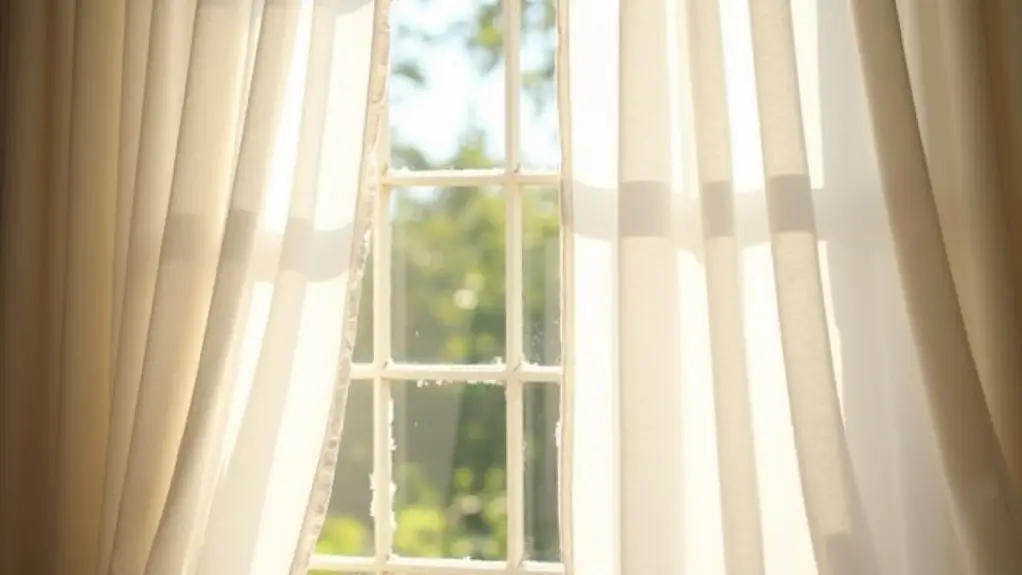
When styling voile fabric, you'll achieve optimal drape by layering sheer pieces strategically, such as pairing a voile overlay with a fitted underlayer. You can enhance voile's natural fluidity by mixing it with structured fabrics like cotton twill or denim.
For versatile seasonal wear, consider lightweight voile scarves and wraps that transition seamlessly from summer coverage to winter layering pieces, while incorporating voile's characteristic open weave structure into your year-round wardrobe.
Layering Techniques
Since voile's inherent sheerness creates endless styling possibilities, mastering layering techniques can elevate your wardrobe's versatility.
When working with cotton voile, layer your blouse over a fitted camisole to maintain the fabric's airy characteristics while ensuring opacity. Silk voile is often draped as an elegant wrap or shawl, enhancing evening attire without compromising breathability.
For maximum visual impact, experiment with contrasting colors beneath sheer voile layers.
You'll achieve a sophisticated dimension by combining different lengths and textures. Consider pairing long voile scarves with structured garments, allowing the fabric's natural drape to create flowing silhouettes while maintaining its lightweight properties.
Combining with Other Fabrics
Although voile's delicate weave structure makes it a standalone beauty, the fabric truly shines when paired strategically with other textiles.
You'll achieve optimal results by combining this lightweight and semi-sheer material with structured fabrics like denim or canvas, creating a balanced interplay between flowing and rigid elements.
Layer voile with chiffon or lace for ethereal depth, or integrate it with knit textiles for enhanced comfort.
When using printed voile, pair it with solid fabrics to create visual contrast.
For technical applications, utilize voile as a soft lining beneath heavier materials, ensuring both structure and comfort.
Accessorizing
The art of accessorizing with voile fabric centers on leveraging its ethereal drape and semi-transparent qualities to create balanced, sophisticated looks.
Cotton voile's natural fiber composition makes it versatile for various styling applications.
- Incorporate cotton voile scarves strategically, allowing the fabric's translucent weave to create depth when layered over solid garments.
- Select embroidered cotton fabrics for statement accessories like headscarves or wraps.
- Layer printed voile pieces over basic cotton garments to achieve textural contrast.
- Utilize voile's lightweight drape for evening shawls or wraps, where the fabric's natural movement enhances formal attire.
Seasonal Styling
Mastering seasonal styling with voile fabric requires understanding its unique fiber and weave characteristics across varying temperatures and occasions.
- For summer, exploit voile's airy weave structure by selecting unlined cotton voile pieces that maximize breathability.
- Layer sheer voile blouses over fitted tanks when transitioning to fall, utilizing the fabric's semi-transparent nature.
- During spring, incorporate printed voile scarves and flowing maxi dresses that showcase the material's superior draping qualities.
- Cotton voile is versatile enough for year-round wear when strategically layered.
- For evening events, choose rayon voile garments that offer elegant movement while maintaining the fabric's characteristic lightweight feel.
Conclusion
Voile fabric is a versatile and lightweight textile that offers a unique combination of softness, breathability, and sheer beauty. Its delicate nature makes it an excellent choice for a variety of applications, from elegant garments to airy home décor elements. Understanding its key characteristics—such as its translucency and drape—can help you make informed decisions when selecting the right projects.


0 comments